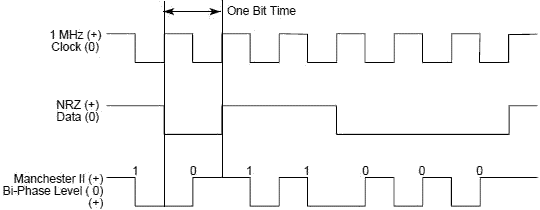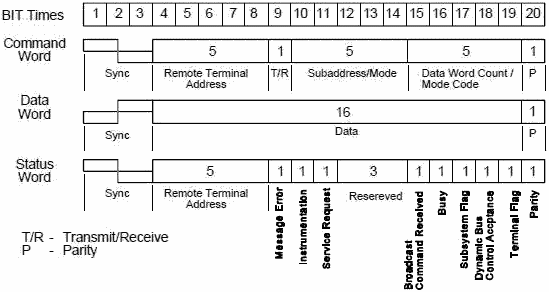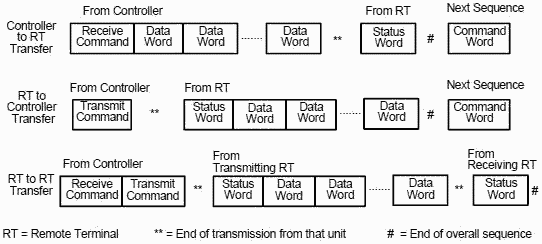Electronic Warfare and Radar Systems Engineering Handbook |
|
MIL-STD-1553 & 1773 DATA BUS PURPOSE In recent years, the use of digital techniques in aircraft equipment has greatly increased, as have the number of avionics subsystems and the volume of data processed by them. Because analog point-to-point wire bundles are inefficient and cumbersome means of interconnecting the sensors, computers, actuators, indicators, and other equipment onboard the modern military vehicle, a serial digital multiplex data bus was developed. MIL-STD-1553 defines all aspects of the bus, therefore, many groups working with the military tri-services have chosen to adopt it. The 1553 multiplex data bus provides integrated, centralized system control and a standard interface for all equipment connected to the bus. The bus concept provides a means by which all bus traffic is available to be accessed with a single connection for testing and interfacing with the system. The standard defines operation of a serial data bus that interconnects multiple devices via a twisted, shielded pair of wires. The system implements a command-response format. MIL-STD-1553, "Aircraft Internal Time-Division Command/Response Multiplex Data Bus," has been in use since 1973 and is widely applied. MIL-STD-1553 is referred to as "1553" with the appropriate revision letter (A or B) as a suffix. The basic difference between the 1553A and the 1553B is that in the 1553B, the options are defined rather than being left for the user to define as required. It was found that when the standard did not define an item, there was no coordination in its use. Hardware and software had to be redesigned for each new application. The primary goal of the 1553B was to provide flexibility without creating new designs for each new user. This was accomplished by specifying the electrical interfaces explicitly so that compatibility between designs by different manufacturers could be electrically interchangeable. The Department of Defense chose multiplexing because of the following advantages:
Some 1553 applications utilize more than one data bus on a vehicle. This is often done, for example, to isolate a Stores bus from a Communications bus or to construct a bus system capable of interconnecting more terminals than a single bus could accommodate. When multiple buses are used, some terminals may connect to both buses, allowing for communication between them. MULTIPLEXING Multiplexing facilitates the transmission of information along the data flow. It permits the transmission of several signal sources through one communications system. BUS The bus is made up of twisted-shielded pairs of wires to maintain message integrity. MIL-STD-1553 specifies that all devices in the system will connect to a redundant pair of buses. This provides a second path for bus traffic should one of the buses be damaged. Signals are only allowed to appear on one of the two buses at a time. If a message cannot be completed on one bus, the bus controller may switch to the other bus. In some applications more than one 1553 bus may be implemented on a given vehicle. Some terminals on the bus may actually connect to both buses. BUS COMPONENTS There are only three functional modes of terminals allowed on the data bus: the bus controller, the bus monitor, and the remote terminal. Devices may be capable of more than one function. Figure 1 illustrates a typical bus configuration.
Figure 1. 1553 Bus Structure
MODULATION The signal is transferred over the data bus using serial digital pulse code modulation.
DATA ENCODING The type of data encoding used by 1553 is Manchester II biphase.
Figure 2. Data Encoding A transition through zero occurs at the midpoint of each bit, whether the rate is a logic one or a logic zero. Figure 2 compares a commonly used Non Return to Zero (NRZ) code with the Manchester II biphase level code, in conjunction with a 1 MHz clock. BIT TRANSMISSION RATE The bit transmission rate on the bus is 1.0 megabit per second with a combined accuracy and long-term stability of +/- 0.1%. The short-term stability is less than 0.01%. There are 20 1.0-microsecond bit times allocated for each word. All words include a 3 bit-time sync pattern, a 16-bit data field that is specified differently for each word type, and 1 parity check bit. WORD FORMATS Bus traffic or communications travels along the bus in words. A word in MIL-STD-1553 is a sequence of 20 bit times consisting of a 3 bit-time sync wave form, 16 bits of data, and 1 parity check bit. This is the word as it is transmitted on the bus; 1553 terminals add the sync and parity before transmission and remove them during reception. Therefore, the nominal word size is 16 bits, with the most significant bit (MSB) first. There are three types of words: command, status, and data. A packet is defined to have no intermessage gaps. The time between the last word of a controller message and the return of the terminal status byte is 4-12 microseconds. The time between status byte and the next controller message is undefined. Figure 3 illustrates these three formats.
Figure 3. 1553 Word Formats COMMAND WORD Command words are transmitted only by the bus controller and always consist of:
These transfers are related to the data flow and are referred to as messages. The basic formats of these messages are shown in Figure 4.
Figure 4. 1553 Data Message Formats
The normal command/response operation involves the transmission of a command from the BC to a selected RT address. The RT either accepts or transmits data depending on the type (receive/transmit) of command issued by the BC. A status word is transmitted by the RT in response to the BC command if the transmission is received without error and is not illegal. Figure 5 illustrates the 1553B Bus Architecture in a typical aircraft.
Figure 5. Typical Bus Architecture MIL-STD-1773 MIL-STD-1773 contains the requirements for utilizing a fiber optic "cabling" system as a transmission medium for the MIL-STD-1553B bus protocol. As such, the standard repeats MIL-STD-1553 nearly word-for-word. The standard does not specify power levels, noise levels, spectral characteristics, optical wavelength, electrical/optical isolation or means of distributing optical power. These must be contained in separate specifications for each intended use. Data encoding and word format are identical to MIL-STD-1553, with the exception that pulses are defined as transitions between 0 (off) and 1 (on) rather than between + and - voltage transitions since light cannot have a negative value. Since the standard applies to cabling only, the bus operates at the same speed as it would utilizing wire. Additionally, data error rate requirements are unchanged. Different environmental considerations must be given to fiber optic systems. Altitude, humidity, temperature, and age affects fiber optics differently than wire conductors. Power is divided evenly at junctions which branch and connectors have losses just as wire connectors do.
Table of Contents for Electronics Warfare and Radar Engineering Handbook Introduction | Abbreviations | Decibel | Duty Cycle | Doppler Shift | Radar Horizon / Line of Sight | Propagation Time / Resolution | Modulation | Transforms / Wavelets | Antenna Introduction / Basics | Polarization | Radiation Patterns | Frequency / Phase Effects of Antennas | Antenna Near Field | Radiation Hazards | Power Density | One-Way Radar Equation / RF Propagation | Two-Way Radar Equation (Monostatic) | Alternate Two-Way Radar Equation | Two-Way Radar Equation (Bistatic) | Jamming to Signal (J/S) Ratio - Constant Power [Saturated] Jamming | Support Jamming | Radar Cross Section (RCS) | Emission Control (EMCON) | RF Atmospheric Absorption / Ducting | Receiver Sensitivity / Noise | Receiver Types and Characteristics | General Radar Display Types | IFF - Identification - Friend or Foe | Receiver Tests | Signal Sorting Methods and Direction Finding | Voltage Standing Wave Ratio (VSWR) / Reflection Coefficient / Return Loss / Mismatch Loss | Microwave Coaxial Connectors | Power Dividers/Combiner and Directional Couplers | Attenuators / Filters / DC Blocks | Terminations / Dummy Loads | Circulators and Diplexers | Mixers and Frequency Discriminators | Detectors | Microwave Measurements | Microwave Waveguides and Coaxial Cable | Electro-Optics | Laser Safety | Mach Number and Airspeed vs. Altitude Mach Number | EMP/ Aircraft Dimensions | Data Busses | RS-232 Interface | RS-422 Balanced Voltage Interface | RS-485 Interface | IEEE-488 Interface Bus (HP-IB/GP-IB) | MIL-STD-1553 & 1773 Data Bus | This HTML version may be printed but not reproduced on websites. |




